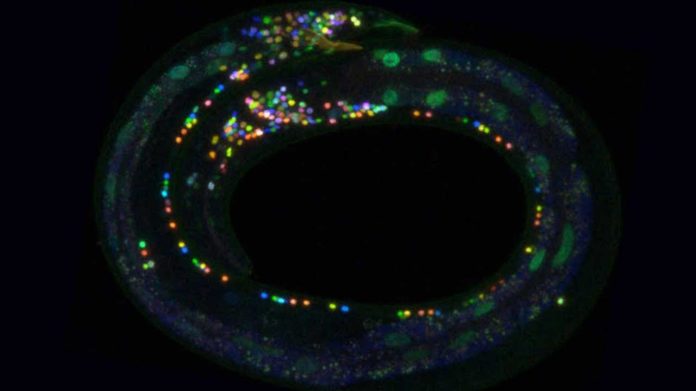Human brain consists of approximately 86 billion neurons or nerve cells. Although, there is still much we don’t know about how neurons work together to give rise to thought or behavior.
Comprehensively resolving neuronal identities in whole-brain images is a significant challenge. But, thanks to a new technique developed by Columbia scientists, it is possible to identify every neuron in a worm’s brain.
The technique called NeuroPAL (a Neuronal Polychromatic Atlas of Landmarks) uses genetic methods to “paint” neurons with fluorescent colors, allowing scientists to determine each neuron in an animal’s nervous system, all while recording a whole nervous system in action.
Oliver Hobert, a professor in the Department of Biological Sciences at Columbia and a principal investigator with the Howard Hughes Medical Institute, said, “It’s amazing to ‘watch’ a nervous system in its entirety and see what it does. The images created are stunning — brilliant spots of color appear in the worm’s body like Christmas lights on a night.”
Scientists achieved comprehensive resolved neuronal identities in C. elegans.
To conduct the study, scientists created two software programs: one that identifies all the neurons in colorful NeuroPAL worm images and a second that takes the NeuroPAL method beyond the worm by designing optimal coloring for potential methods of identification of any cell type or tissue in any organism that permits genetic manipulations.
Eviatar Yemini, a postdoctoral researcher in the Department of Biological Sciences at Columbia and lead author of the study, said, “We used NeuroPAL to record brain-wide activity patterns in the worm and decode the nervous system at work.”
Since the colors are painted into the neuron’s DNA and connected to specific genes, the colors can likewise be utilized to uncover whether these particular genes are available or missing from a cell.
Scientists reported, “the novelty of the technique may soon be overshadowed by the discoveries it makes possible.”
Yemini said, “Being able to identify neurons, or other types of cells, using color can help scientists visually understand the role of each part of a biological system. That means when something goes wrong with the system, it may help pinpoint where the breakdown occurred.”
Journal Reference:
- Eviatar Yemini, Albert Lin, Amin Nejatbakhsh, Erdem Varol, Ruoxi Sun, Gonzalo E. Mena, Aravinthan D.T. Samuel, Liam Paninski, Vivek Venkatachalam, Oliver Hobert. NeuroPAL: A Multicolor Atlas for Whole-Brain Neuronal Identification in C. elegans. Cell, 2020; DOI: 10.1016/j.cell.2020.12.012
